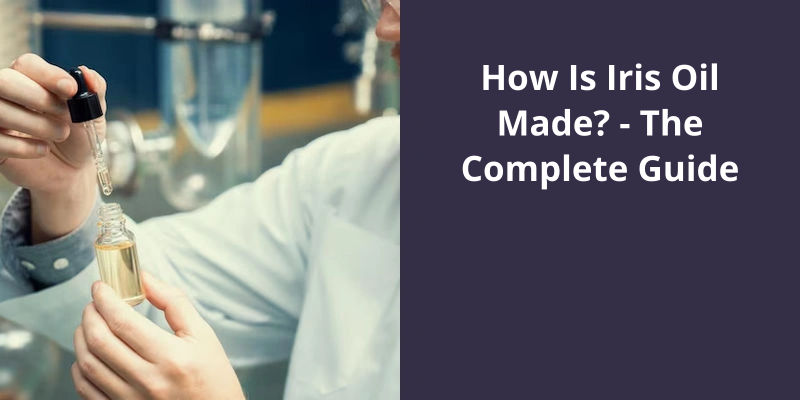Iris oil is made through a meticulous process that starts with the harvesting of iris rhizomes, often called “orris roots.” After collecting these rhizomes, they are peeled, cleaned and left to dry for a couple of years, which allows the scent to develop fully. Once they are dry, the roots are ground into a fine powder, soaked in water and then steam distilled to extract the precious oil. This process can take approximately three to five years from start to finish, which is why iris oil is quite expensive and highly valued in perfumery.

What Is Iris Essential Oil?
While Iris essential oil is primarily known for it’s delightful aroma, it also has a range of potential therapeutic benefits. The oil is often used in aromatherapy to promote relaxation and reduce stress and anxiety. It’s believed to have a calming effect on the nervous system and can be beneficial for those struggling with insomnia or other sleep disorders.
It’s a delicate sweetness that’s complemented by a range of floral, earthy, and green notes. This complexity makes it a versatile ingredient in perfumery, where it’s often used as a top or middle note. It’s subtle nuances and nuances make it an ideal choice for creating elegant and sophisticated fragrances.
To extract Iris essential oil, the roots of the Iris germanica plant are steam distilled. This process ensures that the oil is pure and potent and retains it’s delicate fragrance and therapeutic benefits.
Some people may experience an allergic reaction to the oil, so it’s always advisable to perform a patch test before using it. Additionally, it’s important to source the oil from a reputable supplier to ensure that it’s pure and free from contaminants or additives.
With it’s unique fragrance and therapeutic benefits, it’s no wonder that this precious oil is so highly prized in the world of natural wellness.
Beyond it’s use in the world of perfumery, iris concrete is a fascinating material that’s been used for centuries in the creation of luxury fabrics, cosmetics, and even medicine due to it’s anti-inflammatory properties. Let’s take a closer look at the origins, extraction process, and applications of this precious ingredient.
What Is Iris Concrete?
But what exactly is iris concrete? It’s a highly concentrated material obtained by extracting the roots of the Iris Pallida plant in a process known as enfleurage. Enfleurage is one of the oldest methods of extracting essential oils from plants and involves soaking the plant material in a fat or oil until the fragrance is absorbed. The fat is then washed with alcohol to extract the essential oils, leaving behind a highly aromatic and expensive concrete.
Iris concrete is highly valued in the perfume industry due to it’s unique powdery and earthy scent. It’s also a challenging material to work with as it’s highly volatile and requires a significant amount of skill and knowledge to extract. The cost of iris concrete can vary greatly depending on the quality of the plant material used and the extraction method employed.
It’s known for it’s ability to add an element of sophistication and refinement to fragrances, making it a popular choice for luxury and high-end perfumes.
It’s known for it’s anti-inflammatory and skin-soothing benefits, making it a popular ingredient in skincare products for sensitive and mature skin types.
It’s versatility and therapeutic properties make it an excellent choice for perfumes, cosmetics, and aromatherapy products. It’s rarity and high cost only add to it’s allure and desirability, making it an essential ingredient for any high-quality fragrance.
The Differences Between Iris Concrete and Other Plant Extracts Used in Perfumery
Iris concrete is a specific plant extract used in perfumery that differs from other plant extracts in it’s process of extraction and scent profile. While other plant extracts may be steam distilled or solvent extracted, iris concrete is obtained through a unique process that involves the root of the iris plant being crushed and soaked before being extracted with solvents. Additionally, iris concrete is known for it’s rich and powdery scent, which is distinct from other plant extracts used in perfumery.
In addition to being recognized for their potent antioxidant, anticancer, anti-inflammatory, hepatoprotective, neuroprotective, and anti-microbial properties, Iris species have a variety of other uses. Let’s explore the numerous applications of this versatile plant.
What Can Iris Be Used For?
Iris, also known as the flower flag, has been traditionally used for medicinal purposes for centuries. The herb contains numerous active compounds, including flavonoids, glycosides, and iridoids, which have been proven to have a wide range of therapeutic benefits for the human body. Iris can help to combat cancer, reduce inflammation and support healthy liver and brain function.
Free radicals are unstable molecules that can cause cellular damage and lead to the development of many chronic diseases, including cancer, heart disease and Alzheimers.
Inflammation is a natural response of the body to infection or injury. However, chronic or excessive inflammation can lead to many health problems, including arthritis, heart disease and diabetes. The antioxidant and anti-inflammatory compounds in Iris have been shown to reduce inflammation and improve overall health.
In vitro and in vivo studies have also demonstrated that Iris has potent anti-cancer properties. Researchers have found that the herb can inhibit the growth of cancer cells and induce cancer cell death. Moreover, Iris extract has been found to suppress the growth of tumors in animal models of cancer.
Apart from these properties, Iris is also used for it’s neuroprotective and hepatoprotective effects. Similarly, it’s also been found to protect the brain against damage caused by oxidative stress and inflammation, which can help to prevent the development of neurodegenerative diseases such as Alzheimers and Parkinsons.
Lastly, Iris also exhibits potent antimicrobial properties. Studies have shown that Iris extract can inhibit the growth of many pathogenic bacteria and fungi, including Staphylococcus aureus and Candida albicans. This makes Iris a potentially useful natural treatment for infections caused by these microorganisms.
Overall, Iris has a lot to offer in terms of health benefits.
Conclusion
In conclusion, making iris oil is a laborious and time-consuming process that requires patience, perseverance, and expertise. The use of steam-distillation to extract the valuable compounds from the rhizomes is a crucial step that requires precision and skill. The resulting iris butter is a highly sought-after ingredient in the perfume industry, prized for it’s unique aroma and lasting power. While the process may be costly and time-intensive, the end result is a product that’s truly worth the investment. The art of creating iris oil is a testament to the dedication and passion of the perfumers who strive to capture the essence of nature in their creations.





